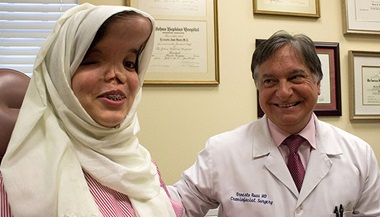Patient Story
Kylie's Story: Hemangioma
Patient Story Highlights
- Kylie, a 4-year-old girl, was born with a hemangioma, a benign tumor that caused an astigmatism in her left eye.
- After propranolol slowed its growth, surgery was performed to remove the remaining tumor when Kylie was three years old.
- The surgery was successful, and Kylie's vision has improved, allowing her to continue practicing her play-archery skills.

Kylie is an extremely active 4-year-old girl. She’s enrolled in gymnastics, swims at the local pool and enjoys being outside. One of her favorite toys is a children’s play bow-and-arrow set—a clear sign of admiration for her father.
“Her dad goes bow hunting,” says Cecilia, Kylie’s mother. “She loves fishing and just being outside.”
Thanks to a recent surgery at Johns Hopkins All Children’s Hospital, Kylie might just trade in her plastic bow for a real one when she’s old enough.
Spotting Trouble
When Kylie was 3 weeks old, Cecilia noticed what seemed like a bruise on her right eyelid. After a trip to the pediatrician, Cecilia learned that the mark was a hemangioma. Hemangiomas are benign tumors that nevertheless can cause problems if they grow in certain areas of the body, such as breathing passages, ears, lips and eyelids.
“We were referred to Johns Hopkins All Children’s, where we saw a cardiologist and eventually an ophthalmologist,” Cecilia says. “They noticed that the hemangioma was causing an astigmatism in Kylie’s left eye.”
After a few months, the hemangioma had grown to the size of a golf ball. Kylie’s cardiologist prescribed propranolol, a beta-blocker that helps slow the growth of tumors and reduce their size. Kylie also wore an eye patch to counteract the astigmatism and strengthen her eye. She responded well to the medication, and the hemangioma stopped growing but remained quite large.
Simple Surgery
Jennifer Mayer, M.D., co-director of the vascular anomalies program at Johns Hopkins All Children’s, weaned Kylie off the medication when she was 2 years old, after it became apparent that the tumor was no longer shrinking.
“Hemangioma growth is stimulated by a protein called VEGF [vascular endothelial growth factor],” Mayer says. “The amount of VEGF delivered to these tumors drops off naturally as children get older, which means that propranolol is no longer needed after a certain point.”
Once Mayer discontinued the propranolol, she and Cecilia entrusted Kylie’s care to Alex Rottgers, M.D., chief of pediatric plastic surgery and co-director of the vascular anomalies program at Johns Hopkins All Children’s.
“With input from our pediatric ophthalmologist, we decided to pursue surgery to remove what was left of the hemangioma,” Rottgers says. “In addition to helping with the astigmatism, doing the surgery at this age helps children avoid problems with self-image and teasing from their peers. This is a concern many parents share.”
Despite the social concerns, Kylie’s parents knew their daughter didn’t mind having a “boo-boo” on her eyelid.
“The hemangioma didn’t bother Kylie at all,” Cecilia says. “My daughter was beautiful before surgery. Our decision to pursue the procedure was really based on the astigmatism alone, rather than any worry about kids at school. Birthmarks are nothing to be ashamed of.”
Rottgers waited until after Kylie turned 3 years old to perform the surgery. On the morning of the procedure, Kylie wasn’t nervous.
“The nurses had some time before the surgery and played with Kylie,” Cecilia says. “She knew they were going to take the boo-boo off her eyelid and wasn’t scared. She didn’t cry. She did great.”
The surgery went off without a hitch.
When Kylie was reunited with her parents, she inquired about a promise the nurses had made hours earlier.
“She woke up almost immediately after coming out of surgery and remembered the nurses promised her an ice pop treat,” Cecilia says. “She got it right away.”
Kylie and her parents went home the next day, and Kylie recovered quickly. After a month, Kylie was left with nothing more than a small surgical scar hidden in the crease of her eyelid.

Happy and Healthy
After returning to Johns Hopkins All Children’s for three follow-up appointments since her surgery, Kylie is cleared for the next two years and will likely require little, if any, treatment in the future.
“She might need a small touch-up procedure when she’s older,” Rottgers says. “But that’s something we can talk about when she’s a teenager.”
All in all, five distinct pediatric specialists—an imaging radiologist, cardiologist and hematologist for medical hemangioma management, ophthalmologist for eye concerns and plastic surgeon for tumor removal—were involved in Kylie’s care.
“We have a multidisciplinary team of more than 20 specialists who can be involved in care for vascular anomalies and birthmarks,” Mayer says. “We meet every Tuesday afternoon as a team to go over patient cases. I’ve seen photos of sweet Kylie after her surgery, and Dr. Rottgers did a stellar job.”
Kylie’s vision has improved since the surgery. She begins pre-K this year and still practices her play-archery skills.
“She hasn’t changed, really,” Cecilia says. “She was already a happy kid.”






